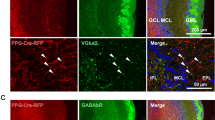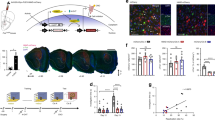Abstract
Sheep learn to recognize the odours of their lambs within two hours of giving birth, and this learning involves synaptic changes within the olfactory bulb1,2. Specifically, mitral cells become increasingly responsive to the learned odour, which stimulates release of both glutamate and GABA (γ-aminobutyric acid) neurotransmitters from the reciprocal synapses between the excitatory mitral cells and inhibitory granule cells1. Nitric oxide (NO) has been implicated in synaptic plasticity in other regions of the brain as a result of its modulation of cyclic GMP levels3,4,5,6,7. Here we investigate the possible role of NO in olfactory learning. We find that the neuronal enzyme nitric oxide synthase (nNOS) is expressed in both mitral and granule cells, whereas the guanylyl cyclase subunits that are required for NO stimulation of cGMP formation8 are expressed only in mitral cells. Immediately after birth, glutamate levels rise, inducing formation of NO and cGMP, which potentiate glutamate release at the mitral-to-granule cell synapses. Inhibition of nNOS or guanylyl cyclase activity prevents both the potentiation of glutamate release and formation of the olfactory memory. The effects of nNOS inhibition can be reversed by infusion of NO into the olfactory bulb. Once memory has formed, however, inhibition of nNOS or guanylyl cyclase activity cannot impair either its recall or the neurochemical release evoked by the learned lamb odour. Nitric oxide therefore seems to act as a retrograde and/or intracellular messenger, being released from both mitral and granule cells to potentiate glutamate release from mitral cells by modulating cGMP contentrations. We propose that the resulting changes in the functional circuitry of the olfactory bulb underlie the formation of olfactory memories.
This is a preview of subscription content, access via your institution
Access options
Subscribe to this journal
Receive 51 print issues and online access
$199.00 per year
only $3.90 per issue
Buy this article
- Purchase on Springer Link
- Instant access to full article PDF
Prices may be subject to local taxes which are calculated during checkout




Similar content being viewed by others
References
Kendrick, K. M., Lévy, F. & Keverne, E. B. Changes in the sensory processing of olfactory signals induced by birth in sheep. Science 256, 833–836 (1992).
Kendrick, K. M. Neurobiological correlates if visual and olfactory recognition in sheep. Behav. Proc. 33, 89–112 (1994).
Garthwaite, J. & Boulton, C. L. Nitric oxide signalling in the central nervous system. Annu. Rev. Physiol. 57, 683–706 (1995).
Dawson, T. M. & Snyder, S. H. Gases as biological messengers: nitric oxide and carbon monoxide in the brain. J. Neurosci. 14, 5147–5159 (1994).
Arancio, O. et al. Nitric oxide acts directly in the pre-synaptic neuron to produce long-term potentiation in cultured hippocampal neurons. Cell 87, 1025–1035 (1996).
Zhuo, M., Small, S. A., Kandel, E. R. & Hawkins, R. D. Nitric oxide and carbon monoxide produce activity-dependent long-term synaptic enhancement in hippocampus. Science 260, 1946–1950 (1993).
Boulton, C. L., Southam, E. & Garthwaite, J. Nutric oxide-dependent long-term potentiation is blocked by a specific inhibitor of soluble guanylyl cyclase. Neuroscience 69, 699–703 (1995).
Furuyama, T., Inagaki, S. & Takagi, H. Localisations of α-1 and β-1 subunits of soluble guanylate cyclase in the rat brain. Mol. Brain Res. 20, 335–344 (1993).
Bannerman, D. M., Chapman, P. F., Kelly, P. A. T., Butcher, S. P. & Morris, R. G. M. Inhibition of nitric oxide synthase does not impair spatial learning. J. Neurosci. 14, 7404–7414 (1994).
Murphy, K. P. S. J., Williams, J. H., Bettache, N. & Bliss, T. V. P. Photolytic release of nitric oxide modulates NMDA receptor-mediated transmission but does not induce long-term potentiation at hippocampal synapses. Neuropharmacology 33, 1375–1385 (1994).
Kishimoto, J., Keverne, E. B., Hardwick, J. & Emson, P. C. Localization of nitric oxide synthase in the mouse olfactory and vomeronasal system: a histochemical, immunological and in situ hybridization study. Eur. J. Neurosci. 5, 1684–1694 (1993).
Fujisawa, H. et al. Expression of two types of nitric oxide synthase mRNA in human neuroblastoma cell lines. J. Neurochem. 63, 140–145 (1994).
Bredt, D. S. et al. Cloned and expressed nitric oxide synthase structurally resembles cytochrome P-450 reductase. Nature 351, 714–718 (1991).
Ogura, T., Yokoyama, T., Fujisawa, H., Kurashima, Y. & Esumi, H. Structural diversity of neuronal nitric oxide synthase mRNA in the nervous system. Biochem. Biophys. Res. Commun. 193, 1014–1022 (1993).
Kendrick, K. M. et al. NMDA and kainate-evoked release of nitric oxide and classical transmitters in the rat stiatum: in vivo evidence that nitric oxide may play a neuroprotective role. Eur. J. Neurosci. 8, 2619–2634 (1996).
Brennan, P. A. & Keverne, E. B. Impairment of olfactory memory by local infusions of non-selective excitatory amino acid receptor antagonists into the accessory olfactory bulb. Neuroscience 33, 463–468 (1989).
Martin, L. J., Blackstone, C. D., Levy, A. I., Huganir, R. L. & Price, D. L. AMPA glutamate receptor subunits are differentially distributed in rat brain. Neuroscience 53, 327–358 (1993).
Garthwaite, J. et al. Potent and selective inhibition of nitric oxide-sensitive guanylyl cyclase by 1H-[1,2,4]oxodiazolo[4,3-a]-1-one. Mol. Pharmacol. 48, 184–188 (1995).
Lévy, F., Locatelli, A., Piketty, V., Tillet, Y. & Poindron, P. Involvement of the main but not the accessory olfactory system in maternal behavior of primiparous and multiparous ewes. Physiol. Behav. 57, 97–104 (1995).
Lévy, F., Gervais, R., Kindermann, U., Orgeur, P. & Piketty, V. Importance of β-noradrenergic receptors in the olfactory bulb of sheep for recognition of lambs. Behav. Neurosci. 104, 464–469 (1990).
Bliss, T. V. P. & Collingridge, G. L. Asynaptic model of memory: long-term potentiation in the hippocampus. Nature 361, 31–39 (1993).
Morris, R. G. M. Synaptic plasticity and learning: selective impairment of learning and blockage of long-term potentiation in vivo by N-methyl-D-aspartate receptor antagonist, AP5. J. Neurosci. 9, 3040–3057 (1989).
Van den Pol, A. N. Presynaptic metabotropic glutamate receptors in adult and developing neurons: autoexcitation in the olfactory bulb. J. Comp. Neurol. 359, 253–271 (1995).
Doze, V. A., Cohen, G. A. & Maddison, D. V. Synaptic localization of adrenergic disinhibition in the rat hippocampus. Neuron 6, 889–900 (1991).
Morris, R. G. M., Anderson, G. S., Lynch, M. & Baudry, M. Selective impairment of learning and blockade of long-term potentiation by an N-methyl-D-aspartate receptor antagonist AP5. Nature 319, 774–776 (1986).
Koesling, D. et al. The primary structure of the larger subunit of soluble guanylyl cyclase from bovine lung: homology between the two subunits of the enzyme. FEBS Lett. 266, 128–132 (1990).
Brune, B. & Lapetina, E. G. Phosphorylation of nitric oxide synthase by protein kinase A. Biochem. Biophys. Res. Commun. 181, 921–926 (1991).
Salter, M., Duffy, C. & Hazelwood, R. Determination of brain nitric oxide synthase inhibition in vivo: ex vivo assays of nitric oxide can give incorrect results. Neuropharmacology 34, 327–334 (1995).
Acknowledgements
This work was supported in part by the Japanese Society for the Promotion of Science (S.O.) and by Consejo Nacional de Ciencia y Technologia y Direccion General del Personal Academico (R.G.)
Author information
Authors and Affiliations
Corresponding author
Rights and permissions
About this article
Cite this article
Kendrick, K., Guevara-Guzman, R., Zorrilla, J. et al. Formation of olfactory memories mediated by nitric oxide. Nature 388, 670–674 (1997). https://doi.org/10.1038/41765
Received:
Accepted:
Issue Date:
DOI: https://doi.org/10.1038/41765
This article is cited by
-
Atmospheric emission of nitric oxide and processes involved in its biogeochemical transformation in terrestrial environment
Environmental Science and Pollution Research (2016)
-
Olfactory Dysfunctions and Decreased Nitric Oxide Production in the Brain of Human P301L Tau Transgenic Mice
Neurochemical Research (2016)
-
Effect of an hyperbaric nitrogen narcotic ambience on arginine and citrulline levels, the precursor and co-product of nitric oxide, in rat striatum
Medical Gas Research (2011)
-
Nitric Oxide Synthase Mediates the Ability of Darbepoetin Alfa to Improve the Cognitive Performance of STOP Null Mice
Neuropsychopharmacology (2010)
-
Inhibition of nitric oxide and soluble guanylyl cyclase signaling affects olfactory neuron activity in the moth, Manduca sexta
Journal of Comparative Physiology A (2007)
Comments
By submitting a comment you agree to abide by our Terms and Community Guidelines. If you find something abusive or that does not comply with our terms or guidelines please flag it as inappropriate.



